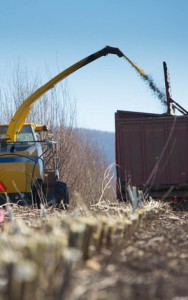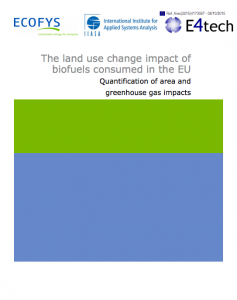 Ethanol Producer magazine is reporting that North Africa, Tunisia-based Biodex-sa is doubling its biodiesel production capacity. The plant currently produces 2.1 million-gallons-per-year. The expansion is expected to be complete by the end of 2016.
Ethanol Producer magazine is reporting that North Africa, Tunisia-based Biodex-sa is doubling its biodiesel production capacity. The plant currently produces 2.1 million-gallons-per-year. The expansion is expected to be complete by the end of 2016.- UNICA is reporting that sugar production from February 1 to March 16, 2016 has produced hydrous and anhydrous ethanol volumes of 180.38 million liters and 39.01 million liters respectively. During this period there was significant conversion of anhydrous ethanol in hydrous ethanol. As a result, the total supply in the first half of the month increased by 269.16 million liters of hydrous ethanol and a drop of 46.74 million liters in the availability of anhydrous ethanol of which UNICA is reporting is normal for this time of year.
- American Science and Technology has announced the completion of its Wausau, WI bio-refinery pilot plant scale up. The new pilot plant increases AST’s processing capacity to 2 tons of cellulosic biomass per day.
- Murex LLC, a leading domestic ethanol marketer and distributer, has announced further market growth with the execution of a multiyear ethanol marketing agreement with White Energy. The agreement calls for Murex LLC to market all three of White Energy’s production locations, two in Texas and one in Kansas, totaling 295mm gallons of permitted ethanol production annually.
Research: Sugar to Biodiesel Better
Researchers at the University of Illinois have discovered a method to economically produce biodiesel from sugarcane as compared to the production of biodiesel from soybean oil. At the beginning of the research, which was designed to find a better way to make biodiesel than using food crops or land needed for food production, the team landed on sugarcane and sweet sorghum as viable options to achieve the goals. An article based on the research was published this month in BIOfpr.
According to lead project investigator Stephen P. Long, U of I crop scientist, the team altered sugarcane metabolism to convert sugars into lipids, or oils, which could been be used to produce biodiesel. While the natural makeup of sugarcane is typically only about 0.05 percent oil, within a year of starting the project, the team was able to boost oil production 20 times, to approximately 1 percent.
Today the so-called “oil-cane” plants are producing 12 percent oil with the team’s ultimate goal of achieving 20 percent oil. Oil cane has additional advantages that have been engineered by the tea iincluding increased cold tolerance and more efficient photosynthesis, which leads to greater biomass production and even more oil.
“If all of the energy that goes into producing sugar instead goes into oil, then you could get 17 to 20 barrels of oil per acre,” Long explains. Today an acre of soybean produces about one barrel or oil. “A crop like this could be producing biodiesel at a very competitive price, and could represent a perpetual source of oil and a very significant offset to greenhouse gas emissions, as well.”
In their analysis, the team looked at the land area, technology, and costs required for processing oil-cane biomass into biodiesel under a variety of oil production scenarios, from 2 percent oil in the plant to 20 percent. These numbers were compared with normal sugarcane, which can be used to produce ethanol, and soybean. An advantage of oil cane is that leftover sugars in the plant can be converted to ethanol, providing two fuel sources in one.
“Modern sugarcane mills in Brazil shared with us all of their information on energy inputs, costs, and machinery. Then we looked at the U.S. corn ethanol industry, and how they separated the corn oil. Everything we used is existing technology, so that gave us a lot of security on our estimates,” Long said.Read More
Penn State Harvests First Shrub Willow Crop
Researchers at Penn State’s College of Agricultural Sciences have completed the harvest of its first experimental crop of shrub willow. The intention of the biomass crop is for use to produce renewable energy and bio-based products. The 34 acres of the shrub willow is part of a five-year program called NEWBio one of seven regional projects of which the goal is to investigate and research sustainable production of woody biomass. Planted in 2012 on land formerly owned by the State Correctional Institution at Rockview, the biomass crop will regrow and will be harvested every three years.

Biomass energy from crops such as shrub willow could provide the social, economic and ecological drivers for a sustainable rural renaissance in the Northeast, researchers say. Photo Credit Penn State.
“The shrub willow stand at Rockview can continue producing biomass for more than 20 years, and we hope to use it both as a source of renewable energy and as a platform for sustainability research,” explained Armen Kemanian, associate professor of production systems and modeling in the Department of Plant Science, one of the lead researchers in the project. “This is an excellent site to investigate impacts on soil and water quality, biodiversity, avoided carbon dioxide emissions, and the potential for growing a regional bio-based economy. Students from our college visit the site and have a firsthand and close-up view of this new crop for the region.”
Kemanian said shrub willow was selected because the perennial likes to be cut. The team is taking advantage of the shrub willow’s vigorous regrowth allowing for multiple harvest cycles. In addition, Kemanian notes the plants also establish a root system that stabilizes the soil and stores substantial amounts of carbon that otherwise would be lost to the atmosphere.
Other advantages of the plant include its ability to store an recycle nutrients leading to little need for fertilizer and an ability to help improve water quality. Increasing perennial vegetation is a critical component of Pennsylvania’s water quality strategy, and these biomass crops allow vulnerable parts of the landscape to remain economically productive while protecting water quality says Kemanian who notes that shrub willow can produce the same amount of biomass as a corn crop with only a third of the nitrogen fertilizer. When the plants grow, they take carbon dioxide from the atmosphere. After harvest, when the biomass is combusted either as wood chips or as a liquid biofuel, the carbon dioxide returns to the atmosphere to complete the cycle.
Researchers believe the NEWBio project could hold an important key to future economic development for the region but first an understanding of how to economically handle the harvesting, transportation and storage of massive volumes, which constitutes 40 to 60 percent of the cost of biomass is needed. The continuation of the research will address these concerns as well.
Illinois Soybean & Partners Promote Biodiesel
The Illinois Soybean Association’s (ISA) B20 Club recently partnered with the Chicago Area Clean Cities Coalition to promote the benefits of biodiesel. Timed with National Biodiesel Day, the B20 Club promotion, sponsored by ISA and the American Lung Association in Illinois, highlighted Illinois-based fleets running on 20 percent (B20) biodiesel blends.
 “By promoting biodiesel’s benefits through CACC, we can play a greater role in reducing our state’s carbon footprint and supporting local economies,” said Gary Berg, soybean farmer from St. Elmo, Ill., and ISA director. “Increased biodiesel consumption supports Illinois farmers by creating more demand for soybean oil, which ultimately builds a more sustainable future for Illinois.”
“By promoting biodiesel’s benefits through CACC, we can play a greater role in reducing our state’s carbon footprint and supporting local economies,” said Gary Berg, soybean farmer from St. Elmo, Ill., and ISA director. “Increased biodiesel consumption supports Illinois farmers by creating more demand for soybean oil, which ultimately builds a more sustainable future for Illinois.”
According to ISA, B20 Club members have chosen biodiesel for its fuel savings and emissions reductions. The club’s combined reduction in carbon dioxide emissions per year is the equivalent of planting 10,638 trees.
“We are grateful for the support of the B20 Club and Illinois Soybean Association. Together, we can create increased awareness about biodiesel’s ease of use and environmental benefits,” added John Walton, vice chairman of Chicago Area Clean Cities. “Last year our coalition’s 150 members had the same effect as removing 53,000 passenger cars from the road. This partnership is likely to increase this positive impact.”
US and Nigerian #Corn Growers Talk #Ethanol
Edwin Uche, director of the Nigerian Corn Growers Association, reached out for a meeting during the recent Maize Genetics Conference in Florida and expressed his excitement for NCGA’s work and enthusiasm for doing similar for farmers in Nigeria. During his visit to the NCGA office, Uche met with Vice President of Production and Stewardship Paul Bertels, Director of Communications Ken Colombini and Director of Development Joe Hodes.
Through a series of in-depth discussions, Uche explored ways in which he could increase corn demand in Nigeria while fostering acceptance of biotechnology and growing the country’s ethanol industry. A proponent of biotechnology in agriculture, Uche also hopes to move more farmers toward this productive technology and away from an ongoing reliance upon open pollinated varieties currently hampering yield in Nigeria.
Discussions yielded insights for NCGA as well. Uche shared his confusion as to how the idea of food versus fuel took hold in the United States, expressing that he sees how corn clearly provides an excellent way to meet both demands simultaneously. Additionally, his pro-biotechnology and pro-ethanol stances fostered hope for potential market growth in Nigeria which could lead to growth in American corn exports to the region.
Work Trucks Favor #Biodiesel
 According to a new 2016 Fleet Purchasing Outlook study conducted by the According to a new 2016 Fleet Purchasing Outlook study conducted by the NTEA – The Association for the Work Truck Industry – biodiesel is now the most commonly used alternative fuel option on the market.
According to a new 2016 Fleet Purchasing Outlook study conducted by the According to a new 2016 Fleet Purchasing Outlook study conducted by the NTEA – The Association for the Work Truck Industry – biodiesel is now the most commonly used alternative fuel option on the market.
Each December, NTEA conducts a comprehensive Fleet Purchasing Outlook Survey to better understand the commercial vehicle landscape, including interest levels for advanced truck technologies and alternative fuels. The new survey results for 2016 show 18 percent of fleets use biodiesel now – up from 15 percent in 2015 – with more fleets planning to acquire or continue using biodiesel than any other alternative fuel option.
“The evolution of alternative fuel technologies is still triggering change for vocational truck specifications,” says Doyle Sumrall, Managing Director of NTEA. “However, general interest has dropped in recent years due to persistently low oil costs and will likely remain muted until prices rebound. Despite current challenges facing the alternative fuels movement, fleet interest in biodiesel has remained strong, actually increasing in 2016 as compared to the previous year.”
 The National Biodiesel Board (NBB) notes that the City of Moline in Illinois has operated its full fleet of over 102 diesel vehicles and equipment on B20, a 20 percent blend of biodiesel with ultra-low sulfur diesel, since 2006 which has helped the city enhance the performance and minimize the maintenance of its vehicles’ fuel systems at a lower cost than diesel fuel.
The National Biodiesel Board (NBB) notes that the City of Moline in Illinois has operated its full fleet of over 102 diesel vehicles and equipment on B20, a 20 percent blend of biodiesel with ultra-low sulfur diesel, since 2006 which has helped the city enhance the performance and minimize the maintenance of its vehicles’ fuel systems at a lower cost than diesel fuel.
J.D. Schulte, Fleet Manager for the City of Moline, stated, “Here in Moline, air quality is paramount to our quality of life. We made the switch to clean, domestically produced plant-based biodiesel ten years ago, not only because it was a good choice for our fleet, but also because it was a good choice for our community. My advice to other fleet managers is, if you are conscious of and serious about air quality and looking for an easy and cost-effective solution to make a positive difference in your community, biodiesel is a natural choice.”
Biodiesel is the first and only commercial-scale fuel to meet the EPA’s definition as an Advanced Biofuel – meaning the EPA has determined that biodiesel reduces greenhouse gas emissions by more than 50 percent when compared with petroleum diesel. In the Gross Vehicle Weight Class 5-8 vehicles that account for 92 percent of on-road diesel / biodiesel fuel use, nearly 90 percent of the medium- and heavy-duty truck OEMs support the use of B20 biodiesel blends.
House Members Urge Reduction in #Ethanol Tariffs
 A bipartisan group of lawmakers sent a letter to U.S. Trade Ambassador Michael Froman this week urging him to examine opportunities to reduce any tariffs on U.S. produced energy, including ethanol, during the Transatlantic Trade and Investment Partnership (T-Tip) negotiations.
A bipartisan group of lawmakers sent a letter to U.S. Trade Ambassador Michael Froman this week urging him to examine opportunities to reduce any tariffs on U.S. produced energy, including ethanol, during the Transatlantic Trade and Investment Partnership (T-Tip) negotiations.
“The U.S. ethanol industry has been unfairly targeted by the EU for increased duties (on ethanol) which have subsequently eliminated U.S. share in the European market,” reads the letter from nine members of Congress. “Currently Europe cannot adequately produce enough ethanol for their own market without importing ethanol from foreign sources, such as the U.S.”
“As T-TIP negotiations progress toward completion,” they continued, “we are confident you can leverage access to all domestic energy sources, such as U.S. natural gas, crude, and ethanol in order to achieve a favorable outcome for these industries and the reduction or elimination of trade obstacles to market access in Europe.”
The European Commission imposed a 9.6 percent duty on U.S. ethanol over three years ago in response to an anti-dumping complaint lodged by European ethanol trade group ePURE. In May 2013, the Renewable Fuels Association (RFA) and Growth Energy filed a complaint with the General Court in Luxembourg which is still being litigated challenging the Commission’s decision.
“The duties imposed were unjustified and blatantly protectionist,” says RFA CEO Bob Dinneen. “Sadly, the real losers in this are European consumers that have to pay more for motor fuel because the lowest-cost liquid fuel in the world — U.S. ethanol — has been targeted by their protectionist policy. Since Europe cannot produce sufficient domestic ethanol supply, and must import the fuel from foreign sources, including the U.S., it is time to see the duties removed.”
RFA, Growth Energy Join USGC
![]() The U.S. Grains Council’s (USGC) membership is expanding. This month the Renewable Fuels Association (RFA) and Growth Energy became official members. Southwest Iowa Renewable Energy (SIRE) and Al-Corn Clean Fuel also joined this month. USGC says their newest members, especially the ethanol trade organizations, will benefit them in multiple ways as they work together to increase global ethanol exports. Both groups will also have seats on USGC’s ethanol Advisory Team.
The U.S. Grains Council’s (USGC) membership is expanding. This month the Renewable Fuels Association (RFA) and Growth Energy became official members. Southwest Iowa Renewable Energy (SIRE) and Al-Corn Clean Fuel also joined this month. USGC says their newest members, especially the ethanol trade organizations, will benefit them in multiple ways as they work together to increase global ethanol exports. Both groups will also have seats on USGC’s ethanol Advisory Team.
![]() “We are proud to have RFA’s and Growth’s full support promoting ethanol overseas,” said USGC Chief Economist Mike Dwyer. “While they have sat on an advisory committee before, now they will really have the chance to engage as members. These organizations specialize in ethanol and offer input and context that will take our A-Team activities and programs to a new level.”
“We are proud to have RFA’s and Growth’s full support promoting ethanol overseas,” said USGC Chief Economist Mike Dwyer. “While they have sat on an advisory committee before, now they will really have the chance to engage as members. These organizations specialize in ethanol and offer input and context that will take our A-Team activities and programs to a new level.”
The 2014/2015 marketing year saw the second largest quantity of U.S ethanol shipped overseas. The organizations are using this as foundation for promoting U.S. ethanol as a clean-burning source of fuel to buyers and end-users around the globe. Lase year, this work was done through ongoing assessments of potential markets; bringing three buyers teams to visit the United States; bringing two groups of U.S. ethanol industry representatives overseas; and a series of workshops focusing on the environmental and economic benefits of ethanol use in China.
This year, this Council’s work will focus on the Asia-Pacific region, particularly Japan, Mexico, India and China as priority markets, with additional opportunities in Peru, the Philippines and other countries that are increasingly receptive to the benefits of blending ethanol into their fuel supplies.
 “With RFA’s and Growth’s growing engagement in these programs, the steering committee is showing their commitment to our work abroad,” Dwyer said. “Developing new markets for fuel ethanol exports offers new opportunity for U.S. corn and sorghum producers and offers us new ways to partner with customers looking to reduce their fuel costs and their environmental impacts.”
“With RFA’s and Growth’s growing engagement in these programs, the steering committee is showing their commitment to our work abroad,” Dwyer said. “Developing new markets for fuel ethanol exports offers new opportunity for U.S. corn and sorghum producers and offers us new ways to partner with customers looking to reduce their fuel costs and their environmental impacts.”
Report Confirms Ethanol’s GHG Reductions
 Earlier this month the European Commission released its new report, “The land use change impact of biofuels consumed in the EU,” (GLOBIOM). The study assessed the (indirect) land use change (LUC) impacts of biofuels demand expected as a result of Europe’s 2020 climate and energy policy. According to the European Renewable Ethanol Association (ePURE), the study found that increased demand for European produced ethanol would have low impacts on land use change and confirms ethanol’s high net greenhouse gas (GHG) savings.
Earlier this month the European Commission released its new report, “The land use change impact of biofuels consumed in the EU,” (GLOBIOM). The study assessed the (indirect) land use change (LUC) impacts of biofuels demand expected as a result of Europe’s 2020 climate and energy policy. According to the European Renewable Ethanol Association (ePURE), the study found that increased demand for European produced ethanol would have low impacts on land use change and confirms ethanol’s high net greenhouse gas (GHG) savings.
The study was conducted by IIASA, Ecofys and E4Tech at the request of the European Commission. The report found that the increased demand from ethanol made from sugar and starch crops, such as corn, along with cellulosic biomass bill have low impacts ILUC. In addition, the study found that this increase in demand will have no impact on food prices through 2020.
Specifically, the study finds that:
- Conventional ethanol feedstocks, such as sugar and starch crops, have much lower land use change emissions impacts than other biofuel feedstocks. For example, in Europe the key feedstocks used to produce ethanol would have LUC emissions of 14g CO2 e/MJ for maize, 15g CO2 e/MJ for sugar beet and 34g CO2 e/MJ for wheat.
- Cellulosic ethanol feedstocks similarly have a low or even positive LUC impact (16g CO2 e/MJ for straw ethanol, 0g CO2 e/MJ if a sustainable straw removal rate is introduced, -12g CO2 e/MJ and -29g CO2 e/MJ for perennials and short rotation crops).
- Land use change impacts and associated emissions can be much lower if: abandoned land in the EU is used for biofuels production; yield increases occur as a result of biofuels demand; and/or peat drainage in Malaysia and Indonesia is halted.
Air New Zealand & Virgin Partner on Aviation Biofuel
The aviation biofuel industry is flying to new heights. Air New Zealand and Virgin Australia have announced a partnership to investigate options for locally produced aviation biofuel. This comes on the heels of the announcement that week that United Airlines is now flying a number of its commercial flights with biojet fuel.
 As part of the initiative, the two airlines have released a Request for Information (RFI) on possible locally-produced biojet fuel. Both airlines say they are committed to ensuring that aviation biofuel delivers environmental, social and economic benefits, and respondents to the RFI are encouraged to address these principles. Companies can express interest through May 30, 2016.
As part of the initiative, the two airlines have released a Request for Information (RFI) on possible locally-produced biojet fuel. Both airlines say they are committed to ensuring that aviation biofuel delivers environmental, social and economic benefits, and respondents to the RFI are encouraged to address these principles. Companies can express interest through May 30, 2016.
Air New Zealand Chief Flight Operations and Safety Officer Captain David Morgan says the airline recognizes the impact aviation has on the environment and this RFI is a key initiative under its carbon management program. “By working in partnership with our alliance partner Virgin Australia we hope we can stimulate the local market, drive innovation and investment and potentially uncover a sustainable biofuel supply suitable for our respective operations,” said Morgan.
“Aviation biofuel offers a significant opportunity for the aviation industry to reduce emissions whilst also building long-term fuel security for the sector,” added Robert Wood, head of sustainability for Virgin Australia. “We are seeing the development of the aviation biofuel industry accelerate internationally but that is not yet the case for our region. We are confident that our collaboration with Air New Zealand to procure a large volume of aviation biofuel will de-risk investment in the sector, creating high-tech, high-skilled jobs in the region.”



